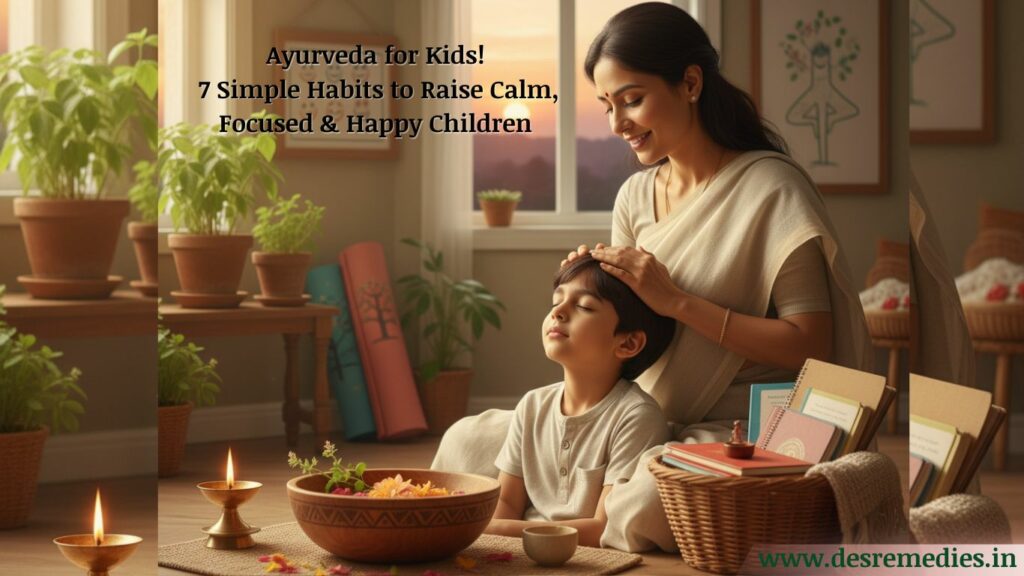
Parenting in today’s world can feel like juggling too many things at once — online classes, homework, gadgets, and the constant rush. Amid all this, our children’s natural calm often gets lost. They feel restless, distracted, and sometimes even anxious.
That’s where Ayurveda for kids comes in — the ancient Indian science of balance that helps us connect back to nature, routine, and emotional peace. It’s not about strict rules or herbs alone — it’s about raising children who are balanced in mind, body, and heart.
As a mother, I’ve seen how bringing Ayurvedic lifestyle habits into our daily routine has made my son, Darsh, calmer, more focused, and emotionally aware. And trust me, these habits are so simple that any parent can easily include them.
So, let’s explore the 7 simple Ayurvedic lifestyle habits that can bring harmony and happiness into your child’s world.
7 Practical Ayurvedic Habits Every Parent Can Start Today
1. Gentle Daily Massage (Abhyanga) – The Power of Touch
In Ayurveda, touch is considered healing — especially for children. A warm oil massage (Abhyanga) not only strengthens their bones and muscles but also nourishes their nervous system, improves blood circulation, and deepens emotional connection.
How to Practice at Home
- Use lukewarm sesame oil in winter and coconut oil in summer.
- Massage gently from head to toe for 5–10 minutes before a bath.
- Use long strokes on arms and legs, and gentle circular motions on joints.
- Make it a calm ritual — play soft music or chant mantras, keep the lights warm.
- Talk to your child, or simply smile — your energy matters.
I usually give Darsh a short evening massage before bath. It helps him sleep peacefully and releases any tension he carries from the day.
Why It Works
Touch creates oxytocin — the “love hormone” that relaxes the child. It also improves sleep, boosts immunity, and reduces anxiety.
In our home, I often whisper affirmations like “You are loved. You are peaceful.” during the massage — that’s pure Ayurveda for kids in practice.
Parent Tip: You don’t have to do it daily — even 3–4 times a week is enough. Try making it a part of your weekend ritual. Kids often start looking forward to their “oil day”!
This simple practice of Ayurveda for kids helps them release emotional stress while bonding deeply with you.
Related read: How Can Ayurvedic Practices Enhance Child Development?
2. Create a Predictable Bedtime Routine
Children feel emotionally safe when they know what comes next. Ayurveda calls this “Dinacharya” — a daily rhythm that supports mental stability.
Late-night screen time, heavy dinners, or overstimulation before bed can make children restless. Instead, a calm, structured bedtime helps their body and mind unwind.
A Calm Evening Routine You Can Try
- Serve an early, light dinner — khichdi, dal-rice, or soup.
- A short walk together after dinner
- No screens at least one hour before bedtime.
- Light a small diya or use a night lamp — soft light signals the body to relax.
- End the day with gratitude — ask your child, “What made you smile today?”
The consistency has improved Darsh’s focus and mood tremendously.
Try this: Create a “Good Night Basket” — fill it with your child’s favorite storybook, soft music, and a gratitude journal. Let them pick one thing each night to close their day peacefully.
Bedtime affirmation: “I rest well. I am safe. Tomorrow will be a happy day.”
Bonus Practice
Try giving your child a warm milk with turmeric or nutmeg (if age-appropriate). It promotes deep sleep and balances Vata energy — the energy linked to movement and restlessness.
When my son and I read stories before bed, it’s not just bonding time — it’s how his mind slows down and resets.
A small change like this builds emotional security and aligns with the wisdom of Ayurveda for kids — keeping their body clock and emotions balanced.
3. Movement and Play – The Ayurvedic Way to Balance Energy
Ayurveda says movement is essential to release “stuck energy.” When children sit too long with screens or books, their natural flow of energy is blocked — leading to irritability or lack of focus.
That’s why Ayurveda for kids encourages daily physical activity — not as a chore, but as joyful play.
Ayurvedic Tips for Active Kids
- Morning sunlight play boosts Vitamin D and energy.
- Introduce simple yoga poses like Tree Pose (Vrikshasana) or Cat-Cow (Marjari Asana).
- Encourage barefoot walking on grass — it balances energy and improves immunity.
- Avoid overstimulation from competitive activities — focus on joy, not pressure.
For younger children:
- Jumping, cycling, or running outdoors is perfect.
- Encourage dancing freely to music.
- Even sweeping or helping around the house counts as movement!
For older children:
- Introduce simple yoga postures like Tadasana, Vrikshasana, or Butterfly Pose.
- Include short breathing breaks between study hours.
When I saw Darsh getting restless during homework, I started adding a “5-minute break dance” rule. He moves, laughs, and comes back refreshed.
Try this at home: Create a “Movement Jar.” Write small activity slips (hop 10 times, dance to one song, do yoga pose) and let your child pick one when they feel bored or angry.
This keeps energy balanced, improves digestion, and enhances focus naturally — all foundations of Ayurvedic well-being.
4. Breathing and Mindfulness for Calm Focus
If there’s one tool every child should learn early, it’s how to breathe consciously. Ayurveda teaches that our breath reflects our mind. When we breathe calmly, our mind naturally settles.
When children learn to breathe deeply, they learn to self-regulate emotions naturally. They don’t need long meditation sessions. Just start with 3–5 minutes daily.
Fun breathing games:
- Balloon Breath: Ask your child to imagine filling a big balloon in their tummy and then letting it go slowly.
- Smell the Flower, Blow the Candle: Inhale like smelling a flower, exhale like blowing a candle.
- Cloud Watch: Lie down and watch the sky — it’s mindfulness made easy!
- Happy Breath Jar: Draw happy faces every time your child finishes a calm breathing session.
At night, we sometimes lie on the bed and say three things we loved about our day, followed by three deep breaths. It’s our mini mindfulness ritual.
Make It Routine
Just 3–5 minutes of mindful breathing before homework or bedtime can improve focus and calm.
I often tell my son, “Your breath is your superpower.” Once he learned to pause and breathe before reacting, his anger and frustration reduced naturally.
Mindfulness is the modern form of Ayurveda for kids — it keeps their emotional world balanced and helps them respond instead of react.
5. A Sattvic Diet for a Peaceful Mind
Ayurveda says — “Ahar hi Vihar ka aadhar hai” or “We are what we digest, not just what we eat.” — food is the foundation of life.
A sattvic diet (pure, light, nourishing food) keeps the mind calm, alert, and positive. For children, it supports better memory, focus, and emotional stability.
In my home, we follow a vegetarian sattvic style.
What a Sattvic Diet Looks Like
- Freshly cooked, warm meals (avoid refrigerated leftovers).
- Include ghee, milk, seasonal fruits, vegetables, and whole grains.
- Limit packaged snacks, sugar-loaded drinks, and deep-fried food.
- Serve food with love — never while watching screens.
Some simple sattvic meal ideas for kids:
- Warm moong dal khichdi with ghee
- Vegetable upma or poha with nuts
- Jaggery and coconut laddoos for snacks
- Herbal teas like tulsi or chamomile instead of cold juices
Easy Practical Swaps
| Regular Option | Ayurvedic Swap |
|---|---|
| Chips / Namkeen | Roasted makhana or peanuts |
| Cold Drinks | Warm lemonade or coconut water |
| Ice Cream | Banana milkshake or date smoothie |
| Bread Pizza | Vegetable chilla or moong dosa |
Practical tip: Try adding color to their plate. Let your child name the rainbow — “green spinach, orange carrot, yellow dal.” It turns eating into a fun mindfulness activity.
And yes — avoid cold, refrigerated foods at night. Ayurveda says warm food brings warmth to emotions too.
At home, I’ve noticed that when meals are served calmly, my child eats better — it’s not just the food, but the energy that nourishes.
Balanced food = balanced mind = balanced child. That’s the true spirit of Ayurveda for kids.
6. Reduce Evening Screen Time
One of the simplest Ayurvedic principles: “What we take in through our senses becomes part of us.”
So, it’s not just food — but also sounds, visuals, and emotions that affect your child’s balance.
According to Ayurveda, evenings belong to the Kapha dosha, which governs calm and rest. To simplify, evening is the time when the mind starts winding down. Bright screens and loud shows confuse the body’s internal clock, leading to poor sleep and irritability.
We now follow a “Digital Sunset” at home. After 7 PM, no gadgets — only music, conversation, or quiet play.
You can try:
- Replace cartoons with a short family walk, board games, drawing, or story time.
- Keep a separate charging zone outside the bedroom.
- Dim the lights after 8 PM.
These small sensory changes soothe the nervous system, preparing the body for rest.
I once noticed my son would wake up cranky after late-night cartoons. We switched to storytelling and simple breathing — within a week, his mornings turned cheerful again.
Affirmation for your child: “I calm my mind every night. I choose peace before sleep.”
Ayurveda reminds us — not every break means a screen; sometimes, silence is the best reset.
It’s such a simple yet powerful practice — one that beautifully connects modern science and Ayurveda for kids.
Also read: Ayurvedic Diet for Teenagers with Hormonal Imbalance: Natural Solutions!
7. Teach Emotional Awareness and Expression
Ayurveda doesn’t separate body and mind.
Ayurveda believes every emotion has an energy — anger heats, fear dries, love nourishes. Teaching children to recognize and release emotions is a gift they’ll use lifelong.
A child who can name and express feelings grows more confident and less reactive.
Every evening, I ask Darsh, “How did you feel today?” Some days he says “Happy,” sometimes “Angry because Lego broke,” sometimes “Sad because my friend didn’t play.”
Instead of dismissing these emotions, we talk about them, name them, and think of what could help next time.
Practical Emotional Practices
- At dinner, play the “Feeling Game” — everyone shares one emotion they felt that day.
- Teach your child that all emotions are okay — even anger or sadness.
- Use affirmations like: “It’s okay to feel upset,” “I can calm myself with my breath,” “I am kind and brave.”
Fun idea: Make an “Emotion Board” with emojis or drawings. Let your child move a magnet each day to show how they’re feeling. It teaches awareness without judgment.
Encourage phrases like:
- “I feel upset, but I can handle it.”
- “It’s okay to be sad.”
- “I can try again.”
Why It Matters
This emotional literacy builds resilience and kindness. When children express emotions openly, they carry less stress in their bodies — better digestion, focus, and energy naturally follow.
That’s Ayurveda for kids — healing from the inside out.
Final Thoughts
Ayurveda isn’t just an ancient science — it’s a way of parenting with awareness, compassion, and rhythm. When we bring small Ayurvedic habits into our child’s daily routine — like warm food, mindful routines, gentle touch, and calm evenings, we’re teaching them the art of balanced living and our children automatically absorb balance, focus, and positivity.
Start small — maybe one change this week. A bedtime ritual, a massage, or mindful breathing. Watch how your child’s energy, emotions, and focus slowly shift.
Because in the end, Ayurveda for kids is not about perfection — it’s about connection.
It’s about raising peaceful hearts in a noisy world. 💛



